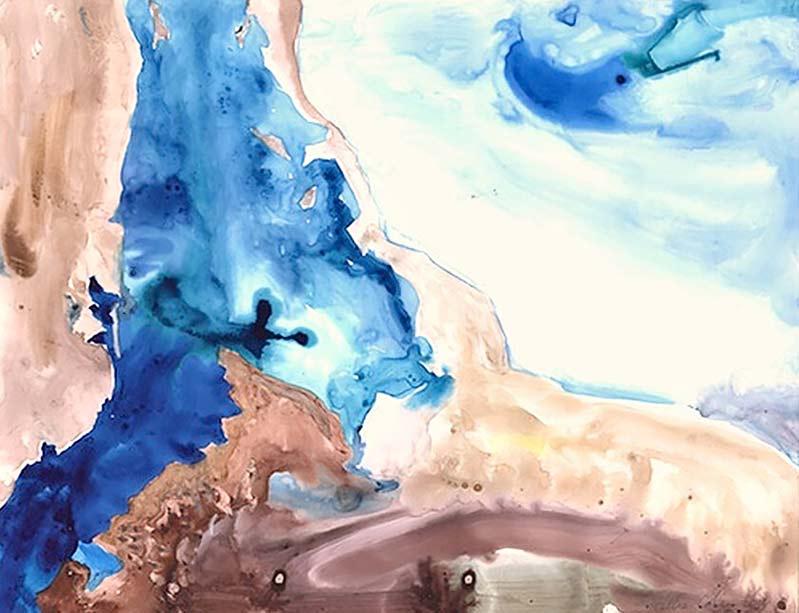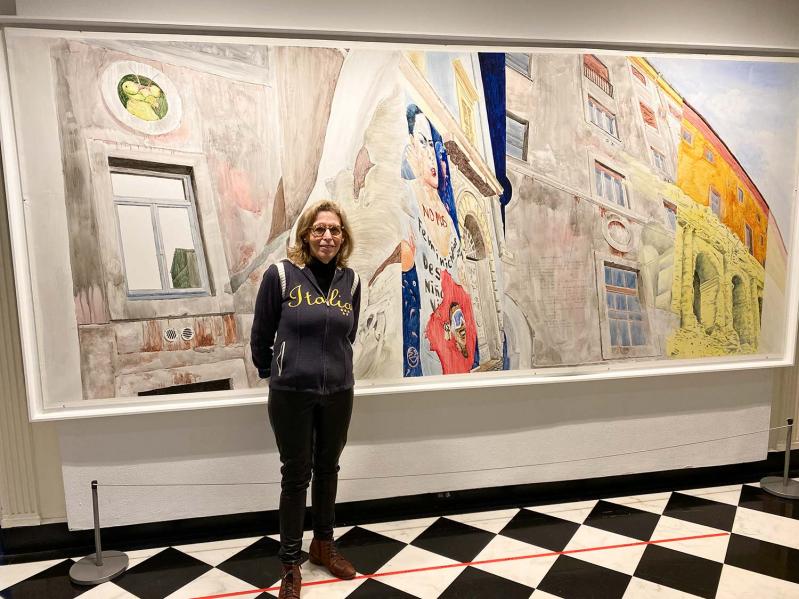Hallie Cohen was a junior at the Tyler School of Art in Philadelphia when she first visited Rome in 1968, painting in a studio that had been occupied years earlier by Philip Guston.
"I was quite transformed by my experience of being in Rome," she said during a recent conversation at Marymount Manhattan College, where she is professor of art and chairwoman of the art and art history department. "I didn't return for more than 40 years. I wanted to keep it in a bell jar of my own experience. I lived there for a year. To come back as a tourist didn't interest me."
When she did return in 2015, with her husband, the writer Francis Levy, it was with a vengeance. With the encouragement of several friends who'd been in the American Academy in Rome's Visiting Artists and Scholars program, the couple submitted a successful proposal, and they have returned every year since except for 2021, when Covid closed the academy.
"Mi Ricordo: Roman Watercolors," an exhibition now at Marymount Manhattan's Hewitt Gallery of Art, consists of eight monumental watercolors created by Ms. Cohen at the academy, one each year since 2016. It is accompanied by short videos narrated by her husband that help contextualize the artworks.
Ms. Cohen has been primarily an abstract painter since art school, but the Roman watercolors are not only figurative, they are cinematic, both in style and content. In fact, the genesis can be traced to Film Forum, a nonprofit showcase in Manhattan for independent and foreign art films.
"We were watching Pier Paolo Pasolini's 1962 film 'Mamma Roma,' and there is a shot of the protagonist lying down at an angle that totally reimagined Mantegna's 'Lamentation of Christ.' " There were other tableaux vivants in the film also taken from art history.
The couple decided to return to the sites where Pasolini filmed "Mamma Roma," and to "do something that connects our practices -- writer and visual artist -- to what was done in the past by filmmakers in Rome," including Federico Fellini and Paolo Sorrentino, as well as Pasolini. Ms. Cohen took photographs of specific sites from the films.
The resulting paintings, each 5 by 12 feet, are segmented left to right, combining different sites in a manner that echoes cinematic montage. "It's the way images can be done in film, but also it's the way the mind works and the memory works," she said. Indeed, "mi ricordo" translates as "I remember."
Ms. Cohen grew up on Manhattan's Upper West Side. Her father sculpted and painted, and eventually left the family business to become a freelance industrial designer. Because he took her to museums, "I have a genetic inclination, plus the environmental experience of being around art when I was young."
She graduated from Hunter College High School, which, she recalled, wasn't very art-focused but did have one program, Integrated Arts, that combined music, performance, and visual art. "That was the first time I could see the arts as integral to my life."
Her father supported her in her desire to attend art school, and Tyler was "an amazing change for me. I was suddenly surrounded by artists and art teachers." She majored in painting and minored in printmaking.
After earning her B.F.A. at Tyler, she attended the Hoffberger School of Painting at the Maryland Institute College of Art, where she studied with the Abstract Expressionist artist Grace Hartigan, an important member of the New York School. While Ms. Cohen was painting in the same style at the time, Hartigan's work was tending toward figuration. "It was a good experience for me. She was a very special, very inspiring woman artist at the time."
Ms. Cohen returned to New York after receiving her M.F.A., and, with a friend from Tyler, found a loft on the Bowery. The friend worked at Marymount Manhattan, and in 1974, when the head of art history fell ill, Ms. Cohen came aboard as an adjunct. She has been there ever since.
She and Mr. Levy were married in 1982 and have two children, ages 39 and 36. The couple rented on the South Fork for many years before buying their current home in Wainscott.
The painter has exhibited her work since the early 1990s, while curating some 20 shows at the college's Hewitt Gallery and another 17, between 2007 and 2011, at the Philoctetes Center for the Multidisciplinary Study of the Imagination, a research foundation. The center, which closed in 2011, was co-founded by Mr. Levy and Edward Nersessian, a psychiatrist.
While Ms. Cohen has painted in oil and acrylic, watercolor has been her primary medium for much of her career. She works on Yupo, a synthetic paper with an impermeable, nonabsorbent surface. "I use a water-soluble paint that puddles on the paper," she explained. "You get very interesting effects when you paint it flat, but if you put it on the wall, which I needed to do for 'Mi Ricordo,' it drips."
Among other things, she uses cotton balls, paper towels, and Q-tips to apply and remove paint. The Q-tips "subtract, but also move and add. The paper gives me a particular surface texture, which I use to create a sense of history and layering, of connecting and disconnecting."
During her first year at the American Academy, she created "Mi Ricordo Roma Blu," a series of large abstract paintings that, like much of her abstract work, are suggestive of water and other forces of nature in flux. "I'm a water sign. I love the ocean. And I stayed with blue for a long time."
Another series, "RNA," created during the pandemic, suggests both water and microorganisms suspended in liquid. "Hydrography," from 2013-14, consists of abstract topographies of real places and either frozen or dynamic bodies of water.

Layering of paint and language informs her "Hic Sum" series from 2015-16. With titles like "I Am Not Mark Rothko" and "I Am Not Cy Twombly," the horizontally striated surfaces are named after artists she admires, and much of the gestural writing repeats their names.
During a tour of the Hewitt Gallery paintings, Ms. Cohen pointed out some specific references. In 1952, Robert Rauschenberg photographed Cy Twombly navigating the Ara Coeli basilica steps. In 2018, Ms. Cohen photographed her husband walking down the same steps, and his legs appear in "Mi Ricordo III," the painting from that year. The history and layering, the conflation of the Rauschenberg image and her photograph, are typical of the series.
Another painting, "Passegiatta" (2023), includes a helicopter with a suspended statue of Christ. That image is from the opening of Fellini's "La Dolce Vita."
Two nuns in "Mi Ricordo Teatro #5" refer to the ecclesiastical fashion show in Fellini's "Roma." The same painting includes the facade of a sound stage at Cinecitta, the Roman film studio where Martin Scorsese filmed "Gangs of New York."
Ovid's "Metamorphosis," with its theme of transformation, informs the most recent painting, "One Arte" (2024), whose title refers to a poem by Elizabeth Bishop. It includes a line from that poem as well as an image of a praying mantis (a nod to Kafka's cockroach) and a contemporary political poster Ms. Cohen photographed in Trastevere.
"In general," said the artist, "I think about the history, and having been interested in and inspired by it, and I think about my contemporary experience. I’m not a history painter, I’m interested in how we experience the past, how we remember, how it impacts us -- but also how we’re having to live with our present circumstances."




